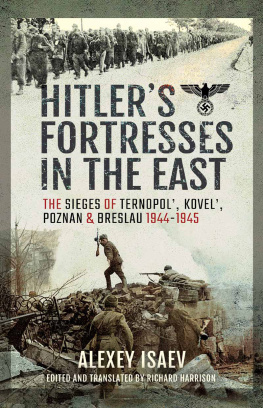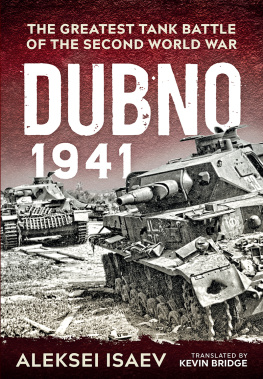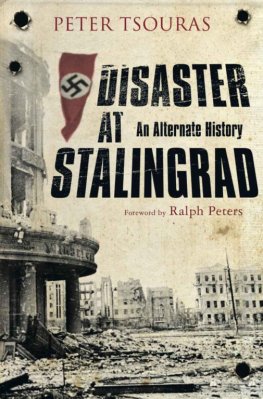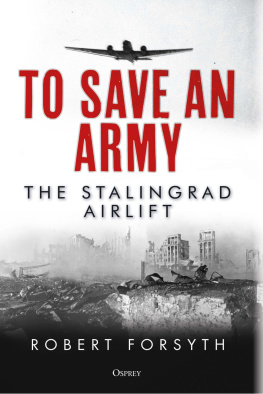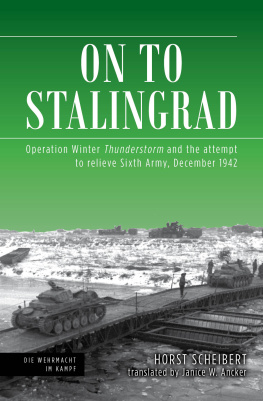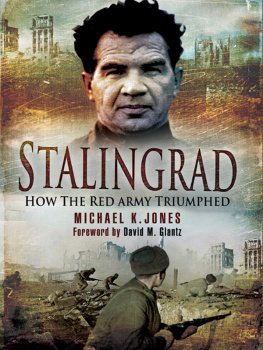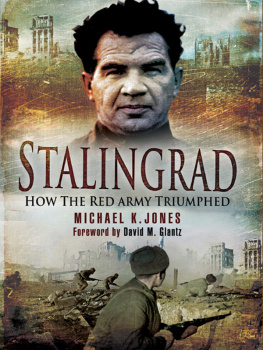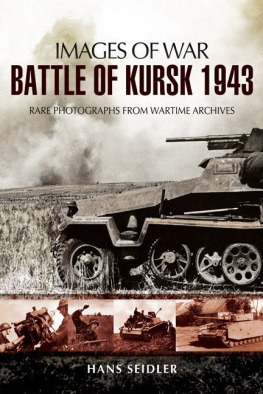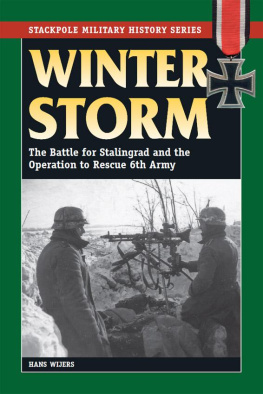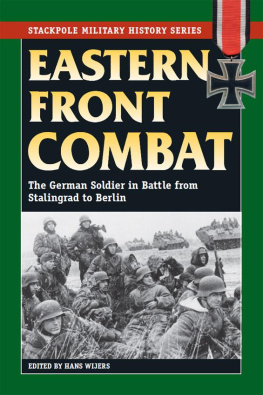Stalingrad
Stalingrad
City on Fire
Alexey V. Isaev
Edited and Translated by Richard W. Harrison
First published in Great Britain in 2019 by
Pen & Sword Military
An imprint of
Pen & Sword Books Ltd
Yorkshire Philadelphia
Copyright Alexey V. Isaev 2019
Copyright English Translation Pen & Sword Books 2019
ISBN 978 1 52674 265 0
eISBN 978 1 52674 266 7
Mobi ISBN 978 1 52674 267 4
The right of Alexey V. Isaev to be identified as Author of this work has been asserted by him in accordance with the Copyright, Designs and Patents Act 1988.
A CIP catalogue record for this book is available from the British Library.
All rights reserved. No part of this book may be reproduced or transmitted in any form or by any means, electronic or mechanical including photocopying, recording or by any information storage and retrieval system, without permission from the Publisher in writing.
Pen & Sword Books Limited incorporates the imprints of Atlas, Archaeology, Aviation, Discovery, Family History, Fiction, History, Maritime, Military, Military Classics, Politics, Select, Transport, True Crime, Air World, Frontline Publishing, Leo Cooper, Remember When, Seaforth Publishing, The Praetorian Press, Wharncliffe Local History, Wharncliffe Transport, Wharncliffe True Crime and White Owl.
For a complete list of Pen & Sword titles please contact
PEN & SWORD BOOKS LIMITED
47 Church Street, Barnsley, South Yorkshire, S70 2AS, England
E-mail:
Website: www.pen-and-sword.co.uk
Or
PEN AND SWORD BOOKS
1950 Lawrence Rd, Havertown, PA 19083, USA
E-mail:
Website: www.penandswordbooks.com
Contents
List of Maps
Map 1. Course of action on the Soviet-German front on the eve of the Stalingrad battle
Map 2. Course of action on the approaches to Stalingrad, JulyAugust 1942
Map 3. Fighting in the Don bend, 23 July6 August 1942
Map 4. Fight for bridgeheads over the Don at Kletskaya and Serafimovich, AugustSeptember 1942
Map 5. Fighting at immediate approaches to the city and the beginning of the assault, 326 September 1942
Map 6. Fighting in the city centre, 1626 September 1942
Map 7. Fighting in the southern part of Stalingrad, 1527 September 1942
Map 8. Stalingrad Front offensive, 18 September 1942
Map 9. The Assault on the City. Course of events during October and November 1942
Map 10. The struggle for the Orlovka and Spartakovka areas, October 1942
Map 11. Fighting for factories and settlements, 27 September18 November 1942
Map 12. The Latashanka landing, 30 October4 November 1942
Map 13. Soviet counteroffensive around Stalingrad, 1930 November 1942
Map 14. Offensive actions of 5th Tank Army and 21st Army, 1923 November 1942
Map 15. The repulse of Winter Storm
Map 16. Operation Ring
List of Illustrations
Plate 1: To your tanks! Tank crews before boarding their tanks in the grounds of the Stalingrad Tractor Factory, summer 1942.
Plate 2: German soldiers filling a water barrel from a well. Drinking water became one of the major problems along the approaches to Stalingrad. (NARA)
Plate 3: Colonel General A.I Yeremenko, the commander of the Stalingrad Front, and N.S. Khrushchev, member of the military council.
Plate 4: T.I. Tanaschishin, commander of the 13th Tank Corps.
Plate 5: The German 733rd Artillery Battalions 210mm howitzer. Heavy artillery became one of the Wehrmachts main arguments in the fighting for Stalingrad. (Authors collection)
Plate 6: A Soviet prisoner of war from the cauldron near Kalach. (NARA)
Plate 7: Soviet engineers build a bridge over the Don.
Plate 8: Soviet soldiers examine captured Italian L6/40 light tanks.
Plate 9: Guards anti-tank rifleman P. Makarenko by an Italian L6/40 tank he knocked out.
Plate 10: Friedrich Paulus, the commander of the Sixth Army at the 76th Infantry Divisions command post in the area of Height 137.2, 25 August 1942. Sitting in front of the commander are General Seydlitz (LI Corps), General Rodenburg (76th Infantry Division) and Colonel Kaegler (commander of Battle Group Kaegler). (NARA)
Plate 11: Its me Chuikov. On 12 September 1942 Lieutenant General V.I. Chuikov took over command of the 62nd Army.
Plate 12: Paulus observes the advance of the LI Corps units on Stalingrad, 14 September 1942. (NARA)
Plate 13: A pump house on the bank of the Volga: the Sixth Army reached this point on 14 September 1942. (NARA)
Plate 14: A T-34 from the 6th Tank Brigade, knocked out on Gogol Street in Stalingrad. (NARA)
Plate 15: The Nazi banner atop the Univermag department store, end of September 1942. No one knew then that the department store would become the symbol of the Sixth Armys capitulation. (NARA)
Plate 16: The centre of Stalingrad shrouded in smoke. The building with the chimney in the centre is Gerhardts mill, which has since become a memorial. (NARA)
Plate 17: German soldiers by the Stalingrad grain elevator, 21 September 1942. (NARA)
Plate 18: The fighting raged day and night. A German 210mm howitzer fires at night. (Authors collection).
Plate 19: How to hold the land bridge? Paulus at his command post. To the right is the commander of the 76th Infantry Division, General Rodenburg and to the left is Elchlepp, chief of the operational section. (NARA)
Plate 20: In search of another decision. G.K. Zhukov in the Stalingrad area, September 1942.
Plate 21: Colonel General Weichs (to the left), commander of Army Group B, in Stalingrad at the LI Corps command post. Beside him are Paulus and Seydlitz (in the side-cap with a folder under his arm). 29 September 1942. (NARA)
Plate 22: Refugees from the combat zone. A photograph from a report by the Sixth Armys headquarters. (NARA)
Plate 23: A middle decision a copy of a German map with the decision for an offensive to the north of Stalingrad.
Plate 24: Colonel Leontii Nikolaevich Gurtev, commander of the 308th Rifle Division.
Plate 25: War in the ruins of an industrial city. Soviet soldiers in position at the base of a gigantic destroyed smokestack in Stalingrad.
Plate 26: Yu.M. Maznyi, commander of the 120th Guards Rifle Regiment.
Plate 27: Colonel I.I. Lyudnikov, commander of the 138th Rifle Division.
Plate 28: At the 138th Rifle Divisions command post. To the right is the commander, Colonel I.I. Lyudnikov. Opposite him from left to right are the divisions military commissar, N.I. Titov, the chief of artillery, Lieutenant Colonel S.Ya. Tychinskii, and the chief of staff, Colonel V.I. Shuba.
Plate 29: I.M. Afonin commanded the 300th Rifle Division as a colonel. He later took part in the capture of Budapest.
Plate 30: The commissars building: the administrative building of the Barricade Factory, built at the beginning of the twentieth century for Vickers Co. personnel.
Plate 31: An armoured launch the workhorse of the Volga Military Flotilla. They were able to supply even the smallest bridgeheads in Stalingrad.
Plate 32: M.S. Shumilov, the commander of the 64th Army. This picture was taken after 1943, when epaulettes were introduced into the Red Army.
Plate 33: The hydraulic press. A 152mm model 1909/30 howitzer from the 1st Artillery Division. (TsAMO)
Plate 34: A Churchill Mk III tank with the serial number T.31221R. This was one of the first tanks of this type to reach the USSR. It later served in the 47th Guards Heavy Tank Regiment around Stalingrad.


